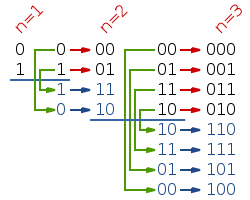89. Gray Code (Medium)
The gray code is a binary numeral system where two successive values differ in only one bit.
Given a non-negative integer n representing the total number of bits in the code, print the sequence of gray code. A gray code sequence must begin with 0.
For example, given n = 2, return [0,1,3,2]. Its gray code sequence is:
00 - 0
01 - 1
11 - 3
10 - 2
Note:
For a given n, a gray code sequence is not uniquely defined.
For example, [0,2,3,1] is also a valid gray code sequence according to the above definition.
For now, the judge is able to judge based on one instance of gray code sequence. Sorry about that.
Solution 1: binary to gray code
vector<int> grayCode(int n) {
vector<int> res;
for (int i = 0; i < pow(2,n); ++i) {
res.push_back((i >> 1) ^ i);
}
return res;
}
Convertion of grey code and binary 格雷码和二进制数之间的转换
/*
The purpose of this function is to convert an unsigned
binary number to reflected binary Gray code.
The operator >> is shift right. The operator ^ is exclusive or.
*/
unsigned int binaryToGray(unsigned int num)
{
return (num >> 1) ^ num;
}
/*
The purpose of this function is to convert a reflected binary
Gray code number to a binary number.
*/
unsigned int grayToBinary(unsigned int num)
{
unsigned int mask;
for (mask = num >> 1; mask != 0; mask = mask >> 1)
{
num = num ^ mask;
}
return num;
}
Solution 2: mirror relection

vector<int> grayCode(int n) {
vector<int> res{0};
for (int i = 0; i < n; ++i) {
int size = res.size();
for (int j = size-1; j >= 0; --j) {
res.push_back(res[j] | 1 << i);
}
}
return res;
}
Solution 3:
维基百科上还有一条格雷码的性质是直接排列,以二进制为0值的格雷码为第零项,第一项改变最右边的位元,第二项改变右起第一个为1的位元的左边位元,第三、四项方法同第一、二项,如此反复,即可排列出n个位元的格雷码。根据这条性质也可以写出代码,不过相比前面的略微复杂,代码如下: